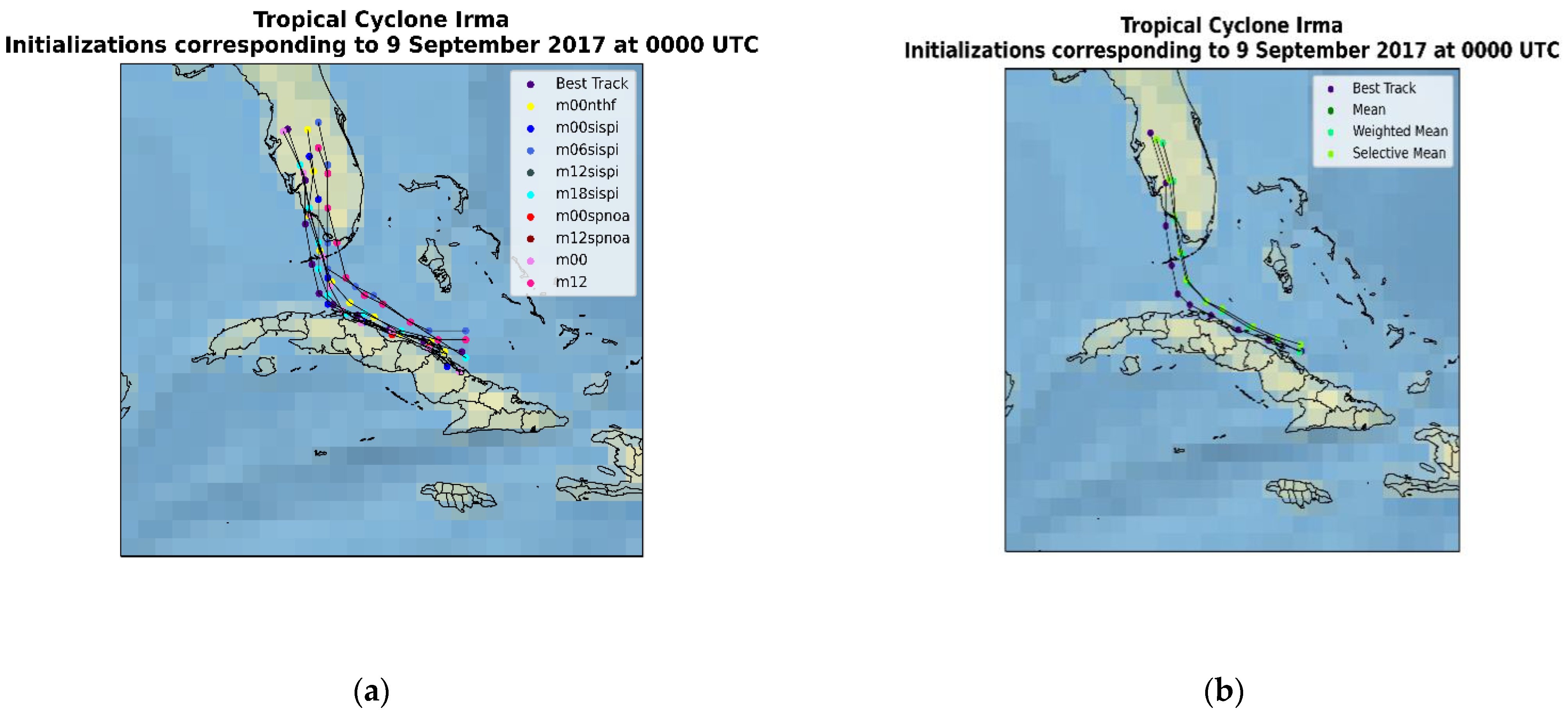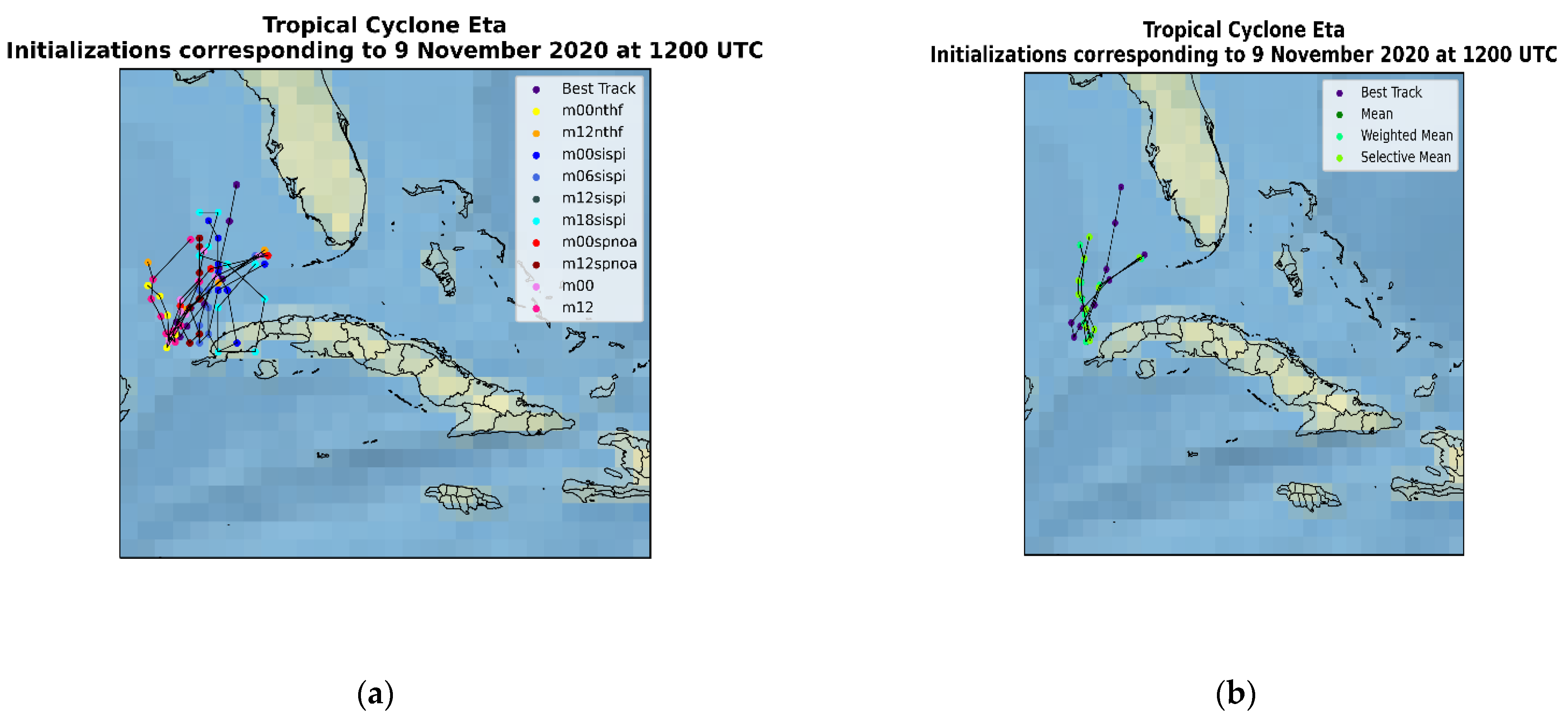Ensemble Prediction of Tropical Cyclone Tracks from NTHF, SisPI and SPNOA Systems †
Abstract
1. Introduction
2. Methods
2.1. Operating Systems in Cuba for Forecasting Tropical Cyclones
2.2. Ensemble Members
2.3. Study Cases
3. Results and Discussion
3.1. Evaluation of the Forecasting Tools NTHF, SisPI and SPNOA
3.2. Performance of the Proposed Ensemble Prediction Systems
3.2.1. Tropical Cyclone Irma
3.2.2. Tropical Cyclone Eta
4. Conclusions
- The evaluation of the NTHF, the SisPI and the SPNOA, for the cases studied, showed that in the first 48 h the NTHF tends to be more precise, but in longer periods the SPNOA stands out as the most precise option.
- The mean and weighted mean variants were the ones that reported the least errors in the initial terms and in the last forecast hours, the selective mean stands out. This is due to that in the first hours there was a greater consensus among the employed members, and for this reason the mean and weighted mean are more effective. With increasing uncertainty over time, members begin to disagree, and so the selective mean is more accurate.
- The degree of improvement of ensembles varies from case to case, but in general they tend to be more accurate than independent forecasts. Regarding the historical errors of the NHC, it can be concluded that the results are promising because they are better in some cases.
Author Contributions
Funding
Institutional Review Board Statement
Informed Consent Statement
Data Availability Statement
Conflicts of Interest
References
- Rubiera, J.; González, C.; Ballester, M.; Llanes, M.; Caymares, A.; Gimeno, Y.; Mojena, E. Curso Sobre Ciclones Tropicales; Academia: Havana, Cuba, 2006. [Google Scholar]
- García-Moya, J.A.; Callado, A.; Escribá, P.; Santos, C.; Santos-Muñoz, D.; Simarro, J. Predictability of short-range forecasting: A multimodel approach. Tellus A Dyn. Meteorol. Oceanogr. 2011, 63, 550–563. [Google Scholar] [CrossRef][Green Version]
- Zhang, Z.; Krishnamurti, T.N. Ensemble forecasting of hurricanes tracks. Bull. Am. Meteorol. Soc. 1997, 78, 2785–2796. [Google Scholar] [CrossRef]
- Zhang, Z.; Krishnamurti, T.N. A perturbation method for hurricane ensemble predictions. Mon. Weather Rev. 1999, 127, 447–469. [Google Scholar] [CrossRef]
- Goerss, J.S. Tropical cyclone track forecasts using an ensemble of dynamical models. Mon. Weather Rev. 2000, 128, 1187–1193. [Google Scholar] [CrossRef]
- Lee, T.C.; Leung, W.M. Performance of multiple-model ensemble techniques in tropical cyclone track prediction. In Proceedings of the 35th Session of the Typhoon Committee, Chiang Mai, Thailand, 19–25 November 2002. [Google Scholar]
- Kotal, S.D.; Roy, S.K. A multimodel ensemble (MME) technique for cyclone track prediction over the North Indian Sea. Geofizika 2011, 28, 275–291. [Google Scholar]
- Jun, S.; Kang, N.; Lee, W.; Chun, Y. An alternative multi-model ensemble forecast for tropical cyclone tracks in the western North Pacific. Atmosphere 2017, 8, 174. [Google Scholar] [CrossRef]
- Nishimura, M.; Yamaguchi, M. Selective ensemble mean technique for tropical cyclone track forecasts using multi-model ensembles. Trop. Cyclone Res. Rev. 2015, 4, 71–78. [Google Scholar]
- Sierra, M.; Morfa, Y.; Fuentes, A.; Ramos, N.; Carnesoltas, M. Herramientas tipo MOS Para la Mejora de las Salidas Numéricas de SisPI, en Particular Para la Precipitación; Instituto de Meteorología: Havana, Cuba, 2019. [Google Scholar]
- Pérez, B.; Mitrani, I.; Díaz, O.O. Sistema de Predicción Numérica Océano-Atmósfera; Technical Report; Atmosphere Physics Center, Institute of Meteorology: Havana, Cuba, 2014. [Google Scholar]
- Mitrani, I.; Pérez, A.; Cabrales, J.; Pove, Y.; Hernández, M.; Díaz, O.O. Coastal flood forecast in Cuba, due to hurricanes, using a combination of numerical models. Rev. Cuba. Meteorol. 2019, 25, 121–138. [Google Scholar]
- Alarcón, A. Artist, Sistema de Pronóstico Numérico de la Intensidad y Trayectoria de los Ciclones Tropicales en Cuba. [Art]; Instituto Superior de Tecnologías y Ciencias Aplicadas: Havana, Cuba, 2019. [Google Scholar]
- Fernández, J.C.; Alarcón, A.; Batista, A.J.; Díaz, O.O. Evaluation of Precipitation Forecast of System: Numerical Tools for Hurricanes Forecast. Adv. Meteorol. 2020, 2000, 8815949. [Google Scholar] [CrossRef]
- Pérez-Alarcón, A.; Fernández-Alvarez, J.C.; Díaz-Rodríguez, O.; Batista-Leyva, A.J.; Pérez-Suarez, R. System for numerical forecast of intensity and trajectory of tropical cyclones in the North Atlantic basin. Rev. Cuba. Meteorol. 2021, 27, 1–14. [Google Scholar]
- Du, J.; Berner, J.; Buizza, R.; Charron, M.; Houtekamer, P.L.; Hou, D.; Jankov, I.; Mu, M.; Wang, X.; Wei, M.; et al. Ensemble Methods for Meteorological Predictions; National Centers for Environmental Prediction (NCEP): Silver Spring, ML, USA, 2018.




| Irma (September 2017) | Fred (August 2021) |
| Laura (August 2020) | Grace (August 2021) |
| Eta (November 2020) | Ida (August 2021) |
| Elsa (July 2021) |
| 0 h | 12 h | 24 h | 36 h | 48 h | 60 h | 72 h | |
|---|---|---|---|---|---|---|---|
| NHC | 11.59 | 38.14 | 58.26 | 78.86 | 102.68 | 134.86 | 151.60 |
| NTHF | 15.82 | 66.56 | 83.40 | 111.86 | 142.450 | 221.11 | 328.16 |
| SisPI | 44.60 | 54.08 | 140.50 | 190.90 | 231.69 | 297.05 | 337.83 |
| SPNOA | 40.35 | 122.87 | 133.07 | 150.63 | 149.88 | 175.14 | 235.81 |
| 0 h | 12 h | 24 h | 36 h | 48 h | 60 h | 72 h | |
|---|---|---|---|---|---|---|---|
| NTHF | 0.99 | 0.97 | 0.97 | 0.95 | 0.94 | 0.91 | 0.87 |
| SisPI | 0.98 | 0.98 | 0.94 | 0.92 | 0.91 | 0.88 | 0.86 |
| SPNOA | 0.98 | 0.95 | 0.95 | 0.94 | 0.94 | 0.93 | 0.90 |
| Initialization | 0 h | 12 h | 24 h | 36 h | 48 h | 60 h | 72 h |
|---|---|---|---|---|---|---|---|
| NTHF | |||||||
| 0000 UTC | 15.21 | 51.45 | 73.11 | 111.30 | 140.06 | 224.07 | 320.15 |
| 1200 UTC | 18.49 | 68.37 | 101.15 | 126.71 | 162.67 | 231.05 | 330.65 |
| SisPI | |||||||
| 0000 UTC | 44.38 | 53.28 | 100.80 | 186.51 | 199.36 | 238.17 | 305.23 |
| 0600 UTC | 58.10 | 58.79 | 114.43 | 169.15 | 219.45 | 264.54 | 303.79 |
| 1200 UTC | 38.34 | 51.24 | 132.08 | 158.08 | 201.85 | 295.81 | 347.09 |
| 1800 UTC | 37.99 | 53.18 | 209.67 | 247.86 | 298.13 | 388.37 | 396.58 |
| SPNOA | |||||||
| 0000 UTC | 43.96 | 62.35 | 67.19 | 92.87 | 124.44 | 163.01 | 211.17 |
| 1200 UTC | 36.40 | 181.71 | 198.95 | 210.18 | 178.16 | 190.66 | 264.94 |
| Mean | Weighted Mean | Selective Mean | NHC (Irma) | NHC (2016–2020) | |
|---|---|---|---|---|---|
| 0 h | 8.48 | 8.89 | 21.36 | - | 11.59 |
| 12 h | 35.72 | 35.55 | 44.75 | 23.82 | 38.14 |
| 24 h | 51.51 | 51.29 | 53.85 | 41.04 | 58.26 |
| 36 h | 51.79 | 51.64 | 53.78 | 60.51 | 78.86 |
| 48 h | 34.50 | 33.86 | 30.39 | 81.27 | 102.68 |
| Mean | Weighted Mean | Selective Mean | NHC (Irma) | NHC (2016–2020) | |
|---|---|---|---|---|---|
| 0 h | 16.76 | 16.62 | 21.77 | - | 11.59 |
| 12 h | 42.93 | 42.70 | 54.09 | 40.56 | 38.14 |
| 24 h | 71.73 | 70.37 | 85.55 | 67.91 | 58.26 |
| 36 h | 45.88 | 45.24 | 63.98 | 103.48 | 78.86 |
| 48 h | 133.26 | 135.22 | 136.58 | 146.45 | 102.68 |
Publisher’s Note: MDPI stays neutral with regard to jurisdictional claims in published maps and institutional affiliations. |
© 2022 by the authors. Licensee MDPI, Basel, Switzerland. This article is an open access article distributed under the terms and conditions of the Creative Commons Attribution (CC BY) license (https://creativecommons.org/licenses/by/4.0/).
Share and Cite
Fundora-Jiménez, L.; Sierra-Lorenzo, M. Ensemble Prediction of Tropical Cyclone Tracks from NTHF, SisPI and SPNOA Systems. Environ. Sci. Proc. 2022, 19, 5. https://doi.org/10.3390/ecas2022-12835
Fundora-Jiménez L, Sierra-Lorenzo M. Ensemble Prediction of Tropical Cyclone Tracks from NTHF, SisPI and SPNOA Systems. Environmental Sciences Proceedings. 2022; 19(1):5. https://doi.org/10.3390/ecas2022-12835
Chicago/Turabian StyleFundora-Jiménez, Lisandra, and Maibys Sierra-Lorenzo. 2022. "Ensemble Prediction of Tropical Cyclone Tracks from NTHF, SisPI and SPNOA Systems" Environmental Sciences Proceedings 19, no. 1: 5. https://doi.org/10.3390/ecas2022-12835
APA StyleFundora-Jiménez, L., & Sierra-Lorenzo, M. (2022). Ensemble Prediction of Tropical Cyclone Tracks from NTHF, SisPI and SPNOA Systems. Environmental Sciences Proceedings, 19(1), 5. https://doi.org/10.3390/ecas2022-12835






